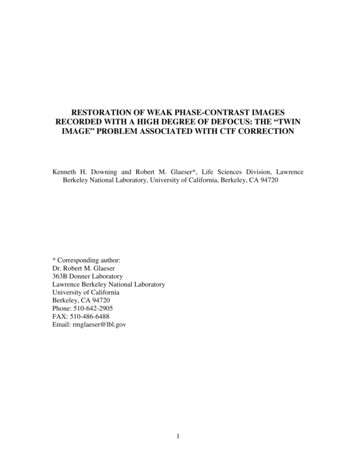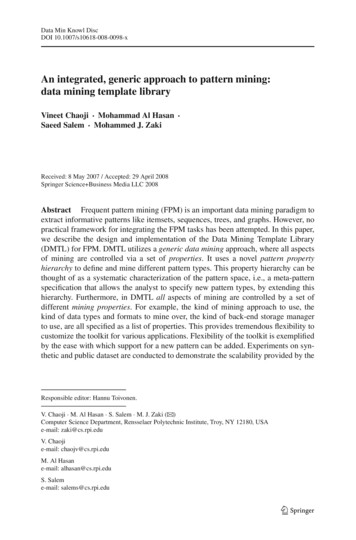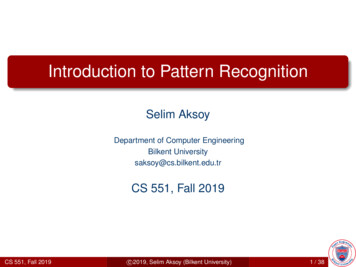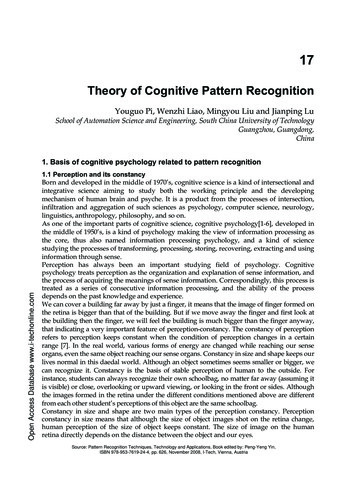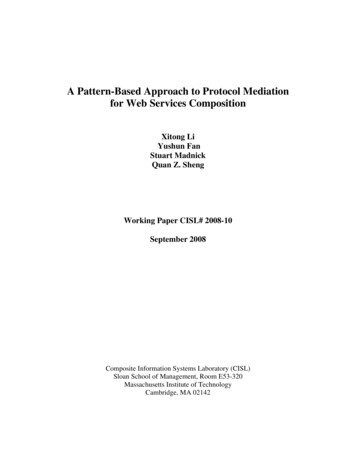
Transcription
A Pattern-Based Approach to Protocol Mediationfor Web Services CompositionXitong LiYushun FanStuart MadnickQuan Z. ShengWorking Paper CISL# 2008-10September 2008Composite Information Systems Laboratory (CISL)Sloan School of Management, Room E53-320Massachusetts Institute of TechnologyCambridge, MA 02142
A Pattern-Based Approach to Protocol Mediation for Web ServicesCompositionXitong Li a,*, Yushun Fan a, Stuart Madnick b, Quan Z. Sheng cabDepartment of Automation, Tsinghua University, Beijing 100084, P.R. ChinaMIT Sloan School of Management, 50 Memorial Drive, Cambridge, MA 02142, USAcSchool of Computer Science, University of Adelaide, Adelaide, SA 5005, Australia* Corresponding authorE-mail address: lxt04@mails.tsinghua.edu.cnAbstractWith the increasing popularity of Service Oriented Architecture (SOA), service composition isgaining momentum as the potential silver bullet for application integration. However, services are notalways perfectly compatible and therefore can not be directly composed. Service mediation, roughlyclassified into signature and protocol ones, thus becomes one key working area in SOA. As achallenging problem, protocol mediation is still open and existing approaches only provide partialsolutions. In this paper, a systematic approach based on mediator patterns is proposed to generateexecutable mediators and glue partially compatible services together. The mediation process and itsmain steps are introduced. By utilizing message mapping, a heuristic technique for identifying protocolmismatches and selecting appropriate mediator patterns is presented. The corresponding BPELtemplates of these patterns are also developed. Moreover, a prototype system, namely ServiceMediation Toolkit (SMT), is implemented to validate the feasibility and effectiveness of our approach.Keywords: Service oriented architecture; Web service; Service composition; Protocol mediation;Mediator1. IntroductionService Oriented Architecture (SOA) is a newly-emerging software architecture consisting ofloosely-coupled services that communicate with each other through open-standard interfaces [1, 2].With the increasing popularity of SOA, service composition is gaining momentum as the potentialsilver bullet for the seamless integration of heterogeneous computing resources, rapid deployment ofnew business applications, and increasing reuse possibilities to a variety of legacy systems [3-5].Based on our observation, however, there exist various challenges that result in theincompatibilities/mismatches of services composition. Firstly, Web services are usually developedseparately and independently. Secondly, services are not unalterable and need evolution. With thevariation of business requirements, service evolution and upgrading have to be addressed. Besides that,services must be interacted with client applications. It is impossible to make these services consistentwith the large number of client applications. Last but not least, software developers can not alwayspredict the deployment and runtime contexts when they develop Web services. As a result, few Webservices are exactly compatible and additional efforts are needed to compose these partially compatibleservices together. By partial compatibility, we mean the situation that two (or more) services providecomplementary functionalities and could be composed together in principal; however, their interfaces
and interaction protocols do not fit each other exactly.An effective solution to these challenges is service mediation, which enables a service requester toconnect to a relevant service provider regardless of the heterogeneities between them and works in atransparent way – neither of them needs to be aware of its existence [6]. First proposed in theEnterprise Service Bus (ESB) industry community [7], service mediation is referred to as the act ofretrofitting existing services by intercepting, storing, transforming, and (re-)routing messages goinginto and out of these services [8]. Nowadays, service mediation has become a key working area in thefield of SOA and Component-Based Software Engineering (CBSE) [9-11].Service mediation can be roughly classified into signature and protocol. Signature mediationwhich focuses on message types has received considerable attention [12-14] and many commercialtools have been developed, such as Microsoft BizTalk Mapper1, Stylus Studio XML Mapping Tools2and SAP XI Mapping Editor3. In comparison, the problem of protocol mediation (also known asprocess mediation), which aims at reconciling mismatches of message exchanging sequences, is stillopen. A frequently-used approach to this issue is to develop a mediator/adapter which is a piece of codethat sits between the interacting services and reconciles the mismatches [15-17]. However, themediators developed by existing approaches have no control logics and can not compensatecomplicated mismatches. Few of these approaches can be used to automatically generate executablecodes of the mediators. Additionally, no existing approach provides a comprehensive solution toprotocol mediation for Web services composition. Last but not least, to the best of our knowledge, thereexists no software tool which assists developers to ease their efforts on mediation tasks, such asidentifying protocol mismatches or generating mediation codes. This paper presents the approaches toresolving these problems.1.1. Motivating ExampleWe present a motivating example that will be used to demonstrate our research idea and approachthroughout the paper, as shown in Fig. 1.(a) BPEL of search engine service(b) BPEL of search client serviceFig. 1. A motivating example of service composition with protocol mismatchesThe example consists of a search client (SC) and a search engine (SE). SC invokes SE by sending itslogin information and the search request respectively. After that, SC waits for the acknowledgement w-software.de/en-sap services-mapping sap xi.mapping-sap-xi.html
the results from SE. On the other hand, after receiving search request, SE starts to search severaldistributed databases one by one (by performing its internal searching action). Once SE finishes adatabase and obtains some searched items, it sends these items to SC immediately. When all databaseshave been searched, SE sends a completing notification to SC and the search work is finished.Among various specification languages of service composition (e.g., BPEL, WS-CDL, WSCI),BPEL obtains the dominance and has been proposed by OASIS as an industry standard which issupported by major software vendors such as IBM, Oracle and SAP. In this paper, we take BPEL as thespecification language for describing the protocol of Web services. Fig. 1 shows the BPEL of the searchengine and the search client services, i.e., SE and SC. It is easy to see that SE and SC are partiallycompatible. They provide complementary functionalities but do not fit each other exactly. Apparently,without reconciling the protocol mismatches between them, SE and SC can not interact with each othersuccessfully.1.2. ContributionsThe rationale of our work has been presented in the conference papers [18, 19]. As an extension ofour previous work, we aim at developing a systematic approach to (semi-)automatically generatingmediators for reconciling all possible protocol mismatches. The main contributions are as follows:1) We present several basic mediator patterns which are derived from basic protocol mismatchesidentified in our previous work [20]. With the knowledge of protocol mismatches, the well-definedbasic mediator patterns can be configured and composed by service developers. These basic mediatorpatterns are referred to as a sufficient set of building blocks which can be used to construct advancedmediators and reconcile all possible protocol mismatches.2) We propose a technique to semi-automatically identify protocol mismatches when two partiallycompatible services need to be composed together. The technique is based on message mappings whichare specified by service developers. By using the technique, basic mediator patterns aresemi-automatically selected according to the identified protocol mismatches.3) We develop BPEL templates for the mediator patterns which can be used to generateexecutable mediation codes. Each mediator pattern has a corresponding BPEL template and acomposite mediator corresponds to a combined BPEL-based mediation code.4) We propose a systematic engineering approach for service developers to reconcile all possibleprotocol mismatches. The approach combines our work on identification of protocol mismatches,selection of mediator patterns and code generation of BPEL-based mediation codes. All thesemediation tasks can be performed (semi-)automatically.5) We develop a prototype system, namely Service Mediation Toolkit (SMT), which provides auser-friendly workbench and can assist service developers to ease their efforts on the mediation tasks.As an implementation work, SMT is integrated with IBM WebSphere Integration Developer (IBMWID)4 and validates the feasibility and effectiveness of our approach.The rest of the paper is structured as follows. In Section 2, several basic mediator patterns areproposed. The configurability and composability of the mediator patterns are presented in this sectionas well. The proposed approach to protocol mediation is presented in Section 3. The technique forselecting mediator patterns based on message mapping is also introduced and BPEL templates of themediator patterns are developed for code generation of executable mediators. And then, the ion/wid/
system, i.e., Service Mediation Toolkit (SMT), is presented in Section 4. In Section 5, related work andthe comparisons with ours are given. Finally, the conclusion and future work are drawn up in Section 6.2. Protocol Mediator Patterns2.1. Basic Mediator PatternsAn effective solution to reconciling protocol mismatches is to develop a mediator. By protocolmismatches, we mean the mismatches that occur in the message exchanging sequences between twopartially compatible services. In our previous work, we have proposed several basic mismatches thatcan be referred to as basic constructs of all protocol mismatches [20]. And we have developed six basicmediators for reconciling the basic mismatches. It has been pointed out that these basic mediators canbe referred to as basic patterns which assist service developers to modularly construct more powerfulmediators and reconcile all possible protocol mismatches [18]. Hence, the set of basic mediatorpatterns is considered to be sufficient. To make this paper self-contained, we present the six basicmediator patterns and corresponding using scenarios in this section. Detailed illustrations of themediator patterns are presented in [18].Note that the protocols of both Web services and mediators are depicted based on Colored PetriNets (CPN) [21]. The benefit of adopting CPN models as an underlying formalism lies in that theyprovide rich analysis capability to support formal verification of protocol mediation and solidapproaches to the transformation between BPEL and CPN models have been developed [22, 23].Details of CPN models are given in [21]. In the following figures, the round places (i.e., circles) depictthe states of control flows of Web services; the gray ellipse places depict the messages of Web servicescommunicated with outside partners. The black transitions (i.e., filled rectangles) depict the operationsof Web services that send/receive messages; the white transitions (i.e., empty rectangles) depict thoseactions without sending/receiving any message. The symbol “MT” stands for a specific message type.(1) Simple Storer pattern: the mediator with the capability of simply receiving and storingmessages. It is used for reconciling mismatches of extra sending messages and missing receivingmessages, as shown in Fig. 2.(a) Extra sending message scenario(b) Missing receiving message scenarioFig. 2. Scenarios of using Simple Storer pattern
(2) Simple Constructor pattern: the mediator with the capability of simply constructing andsending messages. It is used for reconciling mismatches of extra receiving messages and missingsending messages, as shown in Fig. 3.(a) Extra receiving message scenario(b) Missing sending message scenarioFig. 3. Scenarios of using Simple Constructor pattern(3) Splitter pattern: the mediator with the capability of receiving a single message and splitting itinto two or more partial messages. It is used for reconciling mismatches of splitting sending messagesand merging receiving messages, as shown in Fig. 4.(a) Splitting sending message scenario(b) Merging receiving message scenarioFig. 4. Scenarios of using Splitter pattern(4) Merger pattern: the mediator with the capability of receiving two or more partial messages andmerging them into a single one. It is used for reconciling mismatches of splitting receiving messages
and merging sending messages, as shown in Fig. 5.(a) Splitting receiving message scenario(b) Merging sending message scenarioFig. 5. Scenarios of using Merger pattern(5) Storing Controller pattern: the mediator with the capability of storing and conditionallysending some messages in terms of specific logic. It is used for reconciling mismatches of extracondition of receiving messages and missing condition of sending messages, as shown in Fig. 6.(a) Extra condition of receiving message scenario(b) Missing condition of sending message scenarioFig. 6. Scenarios of using Storing Controller pattern(6) Constructing Controller pattern: the mediator with the capability of conditionally constructingand sending some messages in terms of specific logic. It is used for reconciling mismatches of extra
condition of sending messages and missing condition of receiving messages, as shown in Fig. 7.(a) Extra condition of sending message scenario(b) Missing condition of receiving message scenarioFig. 7. Scenarios of using Constructing Controller patternIt should be pointed out that both basic and composite mediators presented in [18] are conceptualpatterns rather than executable codes. As a further step of our work, the intended benefit of the paperlies in semi-automatic selection of mediator patterns and automatic generation of pseudo-code (i.e.,BPEL codes) for protocol mediation.2.2. Configurability and Composability of Mediator PatternsAs mentioned above, a composite mediator can be constructed by basic mediator patterns andreferred to as a new pattern for further use. To facilitate the construction of composite mediators, weinvestigate the configurability and composability of the mediator patterns.The specific structures of the Splitter/Merger pattern are variable according to the sequences ofthe partial messages which may be sequential, parallel or mixed structure. Before generatingpseudo-code of the Splitter/Merger pattern, service developers should specify how many partialmessages involved and the sequence of these messages. For example, service developers may specify asplitter with three partial messages. After receiving a single message MT0, the splitter may sendmessage MT1 and message MT2 in parallel. And it may send the third partial message MT3 aftermessage MT1 is sent out, as shown in Fig. 8. Once service developers configure the sequence of partialmessages, the specific structure of the splitter pattern is identified and automatically concretized by theService Mediation Toolkit (SMT) (see Section 4).When reconciling extra or missing condition mismatches, service developers should specify thecondition constraints of the Storing Controller and Constructing Controller patterns according to thecondition of the provided or required interfaces of services to be composed. The condition constraintsare eventually transformed to BPEL elements, such as switch , pick , while or repeatUntil .For example, there exists a seller service that sends the invoice message after receiving payment fromits buyer. However, the buyer service only expects to receive the invoice under the condition that thetotal payment is greater than 1000 USD. In this case, the Storing Controller pattern can be used toreconcile such mismatch, as shown in Fig. 9. For compatible reconciliation, service developers shouldspecify the internal condition of the Storing Controller pattern. The condition x should be specified as
“Total payment 1000 USD”.Fig. 8. Splitter pattern with three partial messagesFig. 9. Storing Controller pattern with specified conditionIn real-world situations, protocol mismatches are complicated and should be addressed byadvanced mediators with control logics that are composed by the basic mediators. Each mediatorpresented in this paper has two special places, i.e., the initial place and the end place, as shown in Fig.8 and Fig. 9. Informally, the composition of two mediators is performed by merging the common partsof the two mediators, and then merging the end place of one mediator with the initial place of the other.To illustrate the composition of mediators, take a mediator with iterative structure, namely MergingRepeater, for example, as shown in Fig. 10. It’s easy to see that Merging Repeater can iterativelyreceive messages of the type MT1 until the completing condition x occurs. Merging Repeater can beused as a mediator pattern to reconcile protocol mismatches with iterative structure. More details aboutthe configurability and composability of the mediator patterns are given in [18].Fig. 10. Merging Repeater pattern composed by two Storing Controller patterns
3. Proposed Approach to Protocol Mediation3.1. Overview of Mediation ProcessAs BPEL has become the de facto standard for specifying protocols of Web services, we focus onthe mediation of BPEL-based services. We take the BPEL files of two partially compatible services asthe input. And then, we produce executable mediators as the output for reconciling protocolmismatches and compatibly gluing the two services together if the correct mediator exists. Fig. 11shows the mediation approach consisting of five steps.Fig. 11. Overview of the proposed approach(1) Service model transformationAs the first step, BPEL-based services are transformed to formal models for the purpose ofgenerating and verifying mediators. As mentioned above, the formulism of CPN models can not onlydepict the internal logic and message exchanging sequences, but also provide rich analysis capability tosupport solid verification of correctness of protocol mediation. We adopt CPN models to depict theprotocols of services and mediators. Techniques for transforming BPEL-based service models to CPNmodels have been recently proposed in [22, 23].(2) Selection of mediator patternsIt is very challenging to automatically identify protocol mismatches and select mediator patterns.To this end, we propose a heuristic technique based on message mapping that assists service developersto select appropriate mediator patterns for gluing partially compatible services. The role of messagemapping is to define mapping relations for syntactically/semantically equivalent elements of theexchanging messages so that mismatches can be identified. In the WSDL /BPEL specification, messageexchanged between Web services are specified as an aggregation of parts and/or elements. In this paper,we assume that the low-level structures (i.e., data types) of the exchanged messages are consistent.Thus the message mappings are specified at the message and part/element level. By performing aselection rule, appropriate mediator patterns are selected automatically. More details about thetechnique will be presented in Section 3.2.
(3) Mediator configuration and compositionAs mentioned in Section 2.2, the structures and control logics of the mediator patterns need to beconfigured as parameters by service developers according to the identified mismatches. Afterconfiguration, the mediator patterns are composed to construct a composite mediator that reconciles allidentified protocol mismatches. It is noted that a composite mediator can also be referred to as acomplex pattern for further use. Both mediator patterns and composite mediators are depicted asunderlying CPN models for the following formal verification.(4) Mediation verificationThe mediator produced in the above steps is only a conceptual model and should be put betweenthe interacting services. The composition model of the two services and the mediator need to beformally verified. Generally, we consider that the mediation fails if any deadlock exists. Otherwise, themediation is successful. The rationale of the verifying method relies on searching reachable states.Many approaches to formal verification of service composition and mediation are presented in both ourprevious work [17] and literatures of other researchers [24]. Details of mediation verification arebeyond the scope of this paper.(5) Code generation of mediatorsOnly successful mediator will be performed in this step. It is the converse of the first procedure,i.e., transforming CPN models to BPEL-based mediators. To facilitate code generation of executablemediators, BPEL templates for the corresponding mediator patterns are developed. With these BPELtemplates, the pseudo-code for protocol mediation can be produced automatically.3.2. Selection of Mediator PatternsMediator pattern selection is a very challenging issue in the sense that mismatches between twopartially compatible services should be identified first. The appropriate patterns can be selected oncethe mismatches are identified. To the best of our knowledge, few of the existing approaches aredeveloped for (semi-)automatically identifying protocol mismatches and selecting appropriate patterns.As the first step towards this challenge, we propose a heuristic technique based on message mappingfor semi-automatic selection of mediator patterns. By semi-automation, we mean that servicedevelopers should specify the message mappings and adjust the selected patterns. It is noted thatautomatic specification of message mappings is also a challenging problem in the areas of dataintegration, schema mapping and semantic-related researches [25-27], which is a separate researchthread and beyond the scope of this paper.Message mapping M between two partial compatible services is a finite set of mapping relations,i.e., M {mri}. Each mapping relation mri is expressed in the form of source, cnst s, target, cnst t ,where source is a part/element of the sending message and target is the corresponding part/element ofthe receiving message. source/target is expressed in the form of Service.Message.Part. cnst s is theconstraint of the operation that sends source and cnst t is the constraint of the operation that receivestarget. cnst s/cnst t can be NULL if there is no constraint with the sending/receiving message. In themotivating example (see Section 1.1), the receiving message SearchRequest of SE has two parts: loginand request. Thus the part login is a target and expressed as SE.sreq.login, where sreq stands for themessage SearchRequest. For the sake of simplicity, the part name is omitted if the message consists ofonly one part. For example, the sending message Login of SC has only one part login. Thus it is asource and expressed as SC.login. source/target can be NULL if the sending/receiving message doesn’t
exist. The prefix of source/target is the message name of source/target, denoted byprefix(source/target), e.g., prefix(SE.sreq.login) SE.sreq and prefix(SC.login) SC.login.Every mapping relation of M should relate to a certain message. It is not allowed that both thesource and the target of a mapping relation are NULL. For every mapping relation, e.g., mri, we thushave the following two formulas:(i) source(mri) NULL, if target(mri) NULL;(ii) target(mri) NULL, if source(mri) NULL.For every two message mappings, e.g., mri and mrj, the constraints imposed on theirsources/targets should be the same if their sources/targets belong to the same message. Thus we havethe following two formulas:(iii) cnst s(mri) cnst s(mrj), if prefix(source(mri)) prefix(source(mrj));(iv) cnst t(mri) cnst t(mrj), if prefix(target(mri)) prefix(target(mrj)).In terms of the above notation, service developers can specify the message mapping relations, asshown in Table 1.Table 1 Message Mapping Relationsmappingsourcecnst stargetcnst Result while condition( x )SC.totalResultNULLmr5SE.ntfcondition( x )NULLNULLThe first mapping relation (i.e., mr1) indicates that SC sends a message login and SE receives themessage as the part login of its message sreq. There is no constraint with the two operations. We denotethat source(mr1) SC.login and target(mr1) SE.sreq.login. In the fourth mapping relation (i.e., mr4),“ while condition( x )” indicates that the message “SE.partialResult” is sent iteratively under thecondition x. In the fifth mapping relation (i.e., mr5), “condition( x )” indicates that the message “SE.ntf”is sent when the condition x doesn’t hold. We also denote that cnst s(mr5) condition( x ) andcnst t(mr5) NULL.Herein, we introduce a heuristic rule for identifying which mediator pattern should be selected, byusing the mapping relations. For two mapping relations, i.e., mri and mrj, the selection rule is asfollows:Selection Rule of Mediator Patterns(1) if (cnst s(mri) cnst t(mri)) (prefix(source(mri)) prefix(source(mrj))) (prefix(target(mri)) prefix(target(mrj)))then there is no need of mediator patterns;(2) else if (cnst s(mri) cnst t(mri)) (target(mri) NULL)then a Simple Storer pattern is selected;(3) else if (cnst s(mri) cnst t(mri)) (source(mri) NULL)then a Simple Constructor pattern is selected;(4) elseif(cnst s(mri) cnst t(mri)) (prefix(source(mri)) prefix(source(mrj))) (prefix(target(mri)) prefix(target(mrj)))then a Splitter pattern is selected;(5)elseif(cnst s(mri) cnst t(mri)) (prefix(source(mri)) prefix(source(mrj))) (prefix(target(mri)) prefix(target(mrj)))
then a Merger pattern is selected;(6) else if (cnst s(mri) cnst t(mri)) ((cnst s(mri) NULL source(mri) target(mri)) (cnst s(mri) NULL target(mri) NULL))then a Storing Controller pattern is selected;(7) else if (cnst s(mri) cnst t(mri)) ((cnst t(mri) NULL source(mri) target(mri)) (cnst t(mri) NULL source(mri) NULL)then a Constructing Controller pattern is selected;(8) else more complicated mismatches and developers’ intervention is needed.The first part of the selection rule, i.e., sub-rule (1), shows that for two mapping relations, i.e., mriand mrj, their sources belong to the same message, i.e., prefix(source(mri)) prefix(source(mrj)), andtheir targets belong to the same message, i.e., prefix(target(mri)) prefix(target(mrj)), and theconstraints imposed on the source and the target of mri are the same, i.e., cnst s(mri) cnst t(mri), thenwe have the constraints imposed on mri and mrj are all the same, according to Formula (iii) andFormula (iv). Hence, the source message of mri and mrj can be directly related to the target message ofmri and mrj without need of mediation.The second part of the selection rule, i.e., sub-rule (2), shows that a message is sent out by oneservice but the other service doesn’t receive it. In this case, a Simple Storer pattern should be selected.Similarly, the third part of the selection rule, i.e., sub-rule (3), shows that a message is expected to bereceived by one service but the other service doesn’t send it. In this case, a Simple Constructor patternshould be selected.The fourth part of the selection rule, i.e., sub-rule (4), shows that the sources of two mapping rules,i.e., mri and mrj, belong to the same message, but their targets belong to two different messages. In thiscase, a Splitter pattern should be selected. Similarly, the fifth part of the selection rule, i.e., sub-rule (5),shows that the sources of two mapping relations belong to different messages, but their targets belongto the same message. In this case, a Merger pattern should be selected.The sixth part of the selection rule, i.e., sub-rule (6), shows that the Storing Controller patternshould be selected in two cases. In the one case, a message is sent without any constraint but it isreceived with some constraint imposed on it. In the other case, a message is sent with some constraintimposed on it, but it isn’t received by any service.The seventh part of the selection rule, i.e., sub-rule (7), shows that the Constructing Controllerpattern should be selected in two cases. In the one case, a message is sent with some constraintimposed on it but it is received without any constraint. In the other case, a message needs to bereceived under some constraint, but it isn’t sent by any service.The eighth part of the selection rule, i.e., sub-rule (8), shows that there exist more complicatedmismatches between the two service. Usually, developers’ intervention is needed to compose somemediator patterns for reconciling complicated mismatches.Let us consider the motivating example, four mediator patterns can be selected to address themismatches after performing the selection rule. The selected mediator patterns are given as follows:i) A Merger pattern is used to receive SC.login and SC.sreq from SC, and then it sends SE.sreq to SE,where SE.sreq SE.sreq.(login, request). This pattern is selected according to mr1 and mr2.ii) A Simple Constructor pattern is used to construct SC.ack and send it to SC. This pattern isselected according to mr3.iii) A Merging Repeater pattern is used to iteratively receive SE.partialResult from SE until allpartial databases are finished according to mr4. The Merging Repeater merges all p
Enterprise Service Bus (ESB) industry community [7], service mediation is referred to as the act of . Service mediation can be roughly classified into signature and protocol. . [12-14] and many commercial tools have been developed, such as Microsoft BizTalk Mapper1, Stylus Studio XML Mapping Tools2 and SAP XI Mapping Editor3. In comparison .





